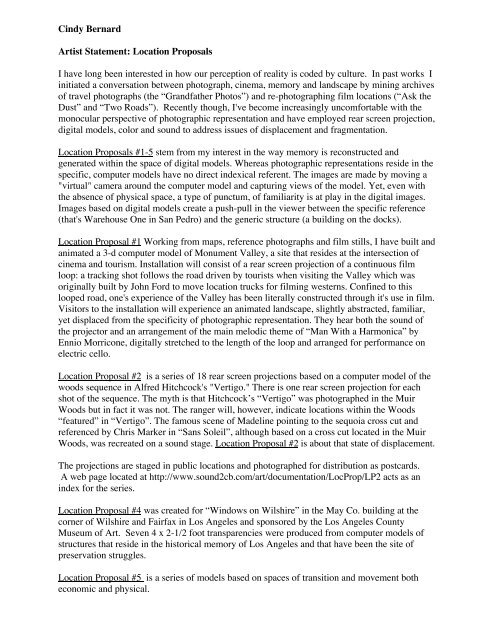Cindy Bernard Artist Statement: Location Proposals I have long ...
Cindy Bernard Artist Statement: Location Proposals I have long ...
Cindy Bernard Artist Statement: Location Proposals I have long ...
Create successful ePaper yourself
Turn your PDF publications into a flip-book with our unique Google optimized e-Paper software.
<strong>Cindy</strong> <strong>Bernard</strong><strong>Artist</strong> <strong>Statement</strong>: <strong>Location</strong> <strong>Proposals</strong>I <strong>have</strong> <strong>long</strong> been interested in how our perception of reality is coded by culture. In past works Iinitiated a conversation between photograph, cinema, memory and landscape by mining archivesof travel photographs (the “Grandfather Photos”) and re-photographing film locations (“Ask theDust” and “Two Roads”). Recently though, I've become increasingly uncomfortable with themonocular perspective of photographic representation and <strong>have</strong> employed rear screen projection,digital models, color and sound to address issues of displacement and fragmentation.<strong>Location</strong> <strong>Proposals</strong> #1-5 stem from my interest in the way memory is reconstructed andgenerated within the space of digital models. Whereas photographic representations reside in thespecific, computer models <strong>have</strong> no direct indexical referent. The images are made by moving a"virtual" camera around the computer model and capturing views of the model. Yet, even withthe absence of physical space, a type of punctum, of familiarity is at play in the digital images.Images based on digital models create a push-pull in the viewer between the specific reference(that's Warehouse One in San Pedro) and the generic structure (a building on the docks).<strong>Location</strong> Proposal #1 Working from maps, reference photographs and film stills, I <strong>have</strong> built andanimated a 3-d computer model of Monument Valley, a site that resides at the intersection ofcinema and tourism. Installation will consist of a rear screen projection of a continuous filmloop: a tracking shot follows the road driven by tourists when visiting the Valley which wasoriginally built by John Ford to move location trucks for filming westerns. Confined to thislooped road, one's experience of the Valley has been literally constructed through it's use in film.Visitors to the installation will experience an animated landscape, slightly abstracted, familiar,yet displaced from the specificity of photographic representation. They hear both the sound ofthe projector and an arrangement of the main melodic theme of “Man With a Harmonica” byEnnio Morricone, digitally stretched to the length of the loop and arranged for performance onelectric cello.<strong>Location</strong> Proposal #2 is a series of 18 rear screen projections based on a computer model of thewoods sequence in Alfred Hitchcock's "Vertigo." There is one rear screen projection for eachshot of the sequence. The myth is that Hitchcock’s “Vertigo” was photographed in the MuirWoods but in fact it was not. The ranger will, however, indicate locations within the Woods“featured” in “Vertigo”. The famous scene of Madeline pointing to the sequoia cross cut andreferenced by Chris Marker in “Sans Soleil”, although based on a cross cut located in the MuirWoods, was recreated on a sound stage. <strong>Location</strong> Proposal #2 is about that state of displacement.The projections are staged in public locations and photographed for distribution as postcards.A web page located at http://www.sound2cb.com/art/documentation/LocProp/LP2 acts as anindex for the series.<strong>Location</strong> Proposal #4 was created for “Windows on Wilshire” in the May Co. building at thecorner of Wilshire and Fairfax in Los Angeles and sponsored by the Los Angeles CountyMuseum of Art. Seven 4 x 2-1/2 foot transparencies were produced from computer models ofstructures that reside in the historical memory of Los Angeles and that <strong>have</strong> been the site ofpreservation struggles.<strong>Location</strong> Proposal #5 is a series of models based on spaces of transition and movement botheconomic and physical.
<strong>Location</strong> Proposal #6 has been performed as a collaboration with sound artists Joseph Hammer(projections+sound) and Gabie Strong, David Patton and Ron Russell (space, climate, lightmood). Working from a list of iconic landscapes derived from film, we use light, color and soundto conjure memories of place displaced from representation. With <strong>Location</strong> Proposal #6, spatialassociations (field, desert, the woods) are generated from a minimum of visual and auralinformation: slides of essential color values and sound abstracted from phenomenon, natural andnot. Norman Klein, in The History of Forgetting, writes that "Simulation is a blur betweenmemory and signifier." In my recent work, I explore the blur.



